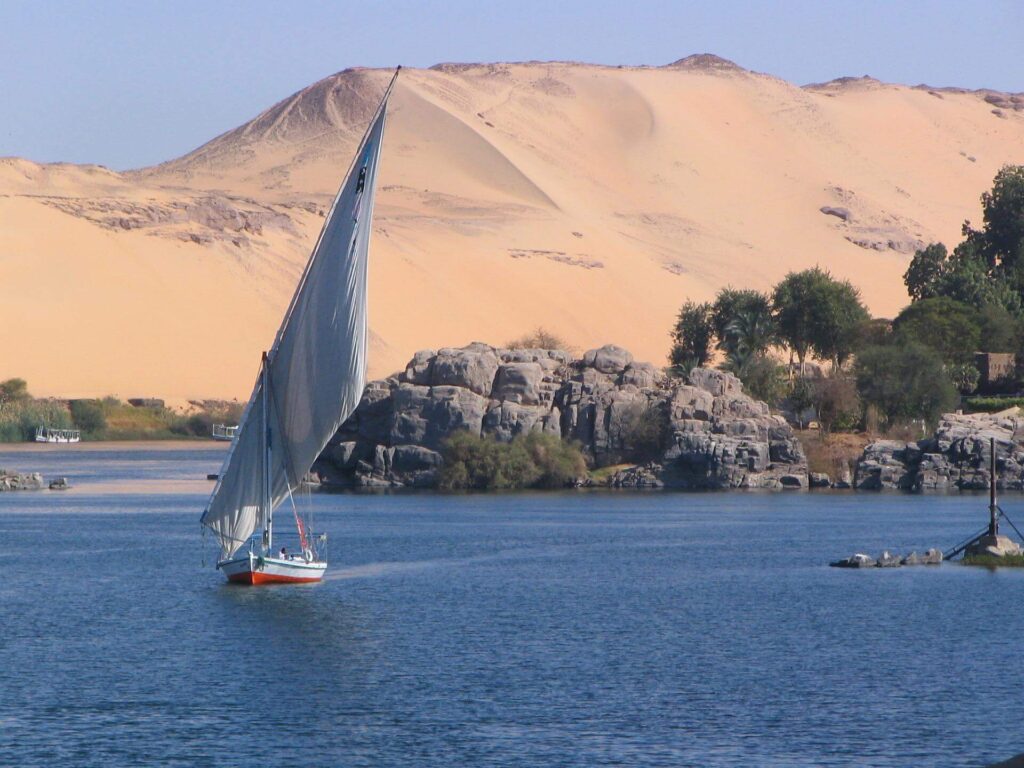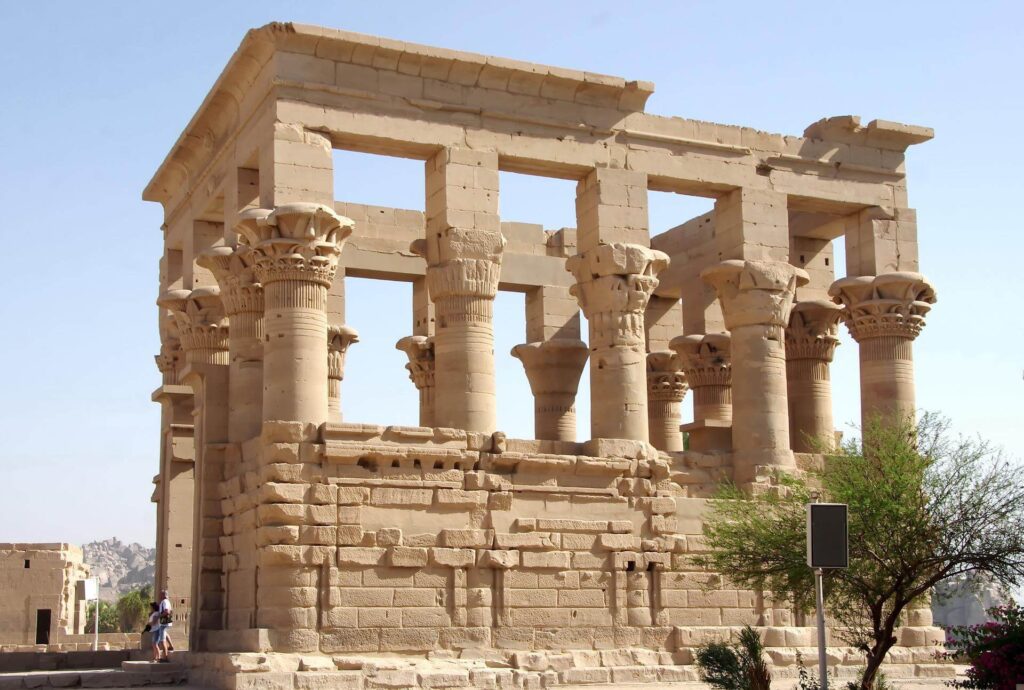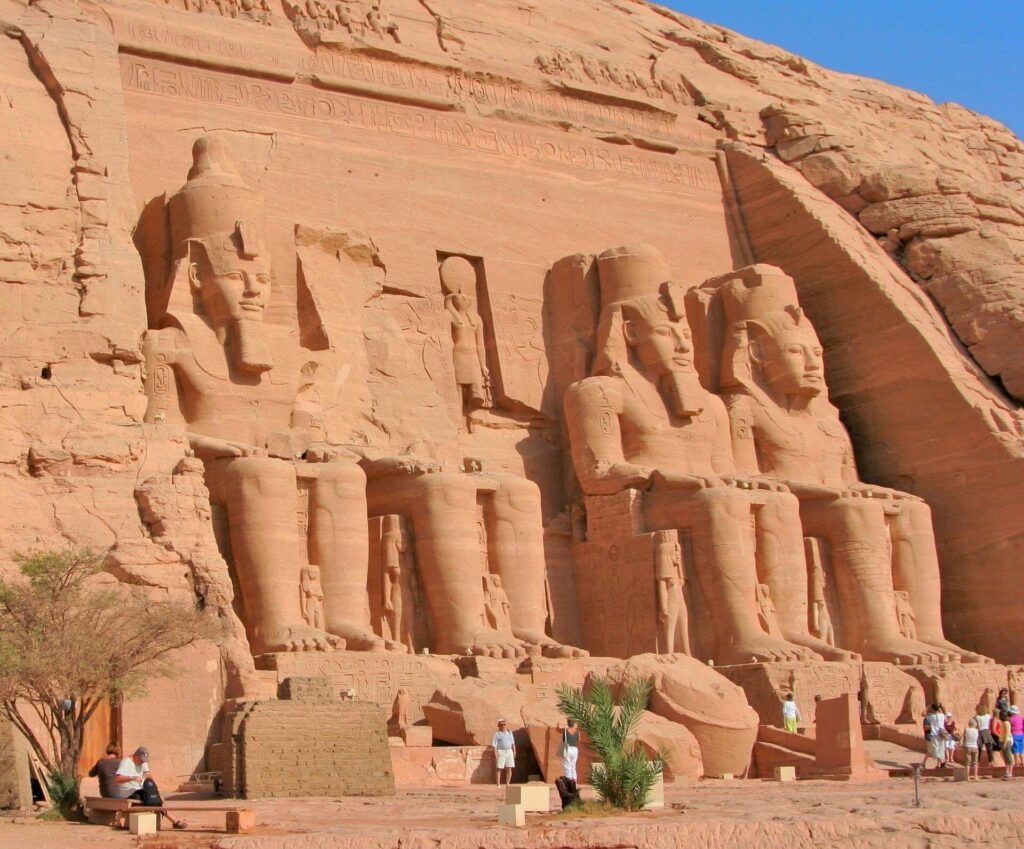Perhaps above any other African country, Egypt is a bucket-list destination in the hearts of many. Beyond visiting the iconic Pyramids, it is Egypt’s cities that travelers’ imaginations visit first, exploring temples, riding on camels, and sailing down the Nile on a felucca.
Out of the many cities in Egypt, we sometimes hear more about Alexandria, Cairo, and Luxor, missing out on the exceptional city of Aswan. Located in the southeast, Aswan is known for its breathtaking views of the Nile, Philae Island, the Monastery of St. Hedra, and its many temples and tombs. It is also home to the Nubian village, Elephantine Island, and Aswan Old Souks (market).
To ensure you have the best experience, we have compiled this guide to visiting Aswan. If you’re interested in visiting these places in person, take a look at our tours in Aswan or get in touch for a custom Egypt travel planning chat with Carol.
Things to Do When Visiting Aswan

See the Temple of Khnum (On Elephantine Island)
When we think of Egypt, it is the ancient gods and temples that first come to mind. The first temple in Aswan we recommend visiting is the Temple of Khnum on Elephantine Island. Khnum was the ram-headed Ancient Egyptian God of Creation.
However, that is not all Khnum is known for. Worshipped during the Old Kingdom (2613-2181 BCE), Khnum is believed to be the creator of the Nile; humankind, which he made from clay on his pottery wheel along with their “ka” (spirit); and he provided enough black silt to fertilize the lands of Africa the Nile touched.
To pay homage to the God of Creation, Roman Emperor Claudia continued Ptolemy VI’s project in the first century. Sadly, all that is left of the temple is the Great Hypostyle Hall, so we are unable to see the temple in all of its former glory.
Don’t let that deter you, however, as we all know the Ancient Egyptians honored those who had died using carvings on the walls and tombs. The Temple is held by 24 columns that are decorated with 16 different palms and plants.
On the walls of the interior, various texts depicting hymns to Khnum, honor the annual sacred festival of Isna with carvings of scenes in the nearby village.
Written descriptions don’t provide a clear image and most of the beauty gets lost. That is why we highly recommend visiting the temple in person. Nothing compares to seeing the Temple of Khnum first-hand.
Visit the Temple of Philae Complex


Due to annual floods and the construction of the lower and higher Aswan dams, the island of Philae was submerged. In 1960 with the help of UNESCO, the Philae Temple Complex (dedicated to the Goddess Isis, her husband Osiris, and her son Horus) was saved and relocated.
Now located on Agilkia Island, visitors can admire the craftsmanship that depicts the legend of the Goddess of life, healing and magic, and her husband.
For many, the Temple of Isis is one of the finest ancient temples in Egypt and we highly recommend adding it to your itinerary.
Be Awed on a Day Trip to the Abu Simbel Temples


We can’t offer a guide to visiting Aswan without mentioning the temples of Abu Simbel. Although Abu Simbel is arguably far enough away that it’s not really part of Aswan. However, Aswan is the closest place tourists are likely to stay when they visit these ancient temples, so most people who visit Abu Simbel will do it as a day trip from Aswan.
Pharaoh Ramesses II and his wife, Queen Nefertari, planned and executed this build during the 13th century BCE. Abu Simbel is split into two temples: The Great Temple and the Small Temple.
As with the Philae Temple, the Abu Simbel temples are no longer located on their original grounds. They were also moved to higher ground to avoid submersion by the Nile after the construction of the Aswan Dam.
Standing between 40ft and 90ft high, the temples can be seen from across the water, along with the statues of Pharaoh Ramesses II and Queen Nefertari.
On closer inspection, visitors will see depictions beneath the Ancient Egyptian Royals. These depictions are of the enemies Ramesses II had conquered: the Nubians, Libyans, and Hittites.
At night, visitors can experience the light show that takes place, bringing ancient creations and modern technology together.
Inside the Great Temple, carvings on the walls show scenes of the Battle of Kadesh, one of Ramesses II’s greatest victories. They also depict Ramesses II and his wife Nefertari giving offerings to the Gods, as well as displaying paintings of the Goddess Hathor.
Tips for Visiting Aswan
We wanted to wrap up by offering some quick tips to help you prepare for your visit to Aswan and Egypt in general.
Visa
A tourist visa is required to gain entry to Egypt. For information on British visas click here; it will take you to the UK Egypt Consulate website. For visa information for your country of origin, please visit your country’s Egyptian consulate website. Many countries can purchase a visa on arrival for $25. This can be obtained in advance by Mr & Mrs Egypt; please contact us for more details.
Travel insurance
We always recommend that you obtain travel insurance to be best prepared for a trip. Find coverage for all the activities you intend to do, including adventure activities like scuba diving.
Clothing
Egypt is a predominantly Islamic country, so make sure to dress modestly, choosing breathable clothes.
Tipping
This may confuse European visitors as tipping isn’t a part of the culture. However, tipping is common in Egypt with a general rule of thumb being to tip 10% of your bill (similar to the UK). This said, some places may not accept tips, so it is important to make sure ahead of time. If in doubt, you could ask your tour guide or even ask your waiting staff.
There is so much more to say about Aswan, but we hope we’ve left you suitably inspired and informed. Aswan more than deserves a space on your Egypt Itinerary and we hope Mr & Mrs Egypt can be part of your next Egyptian adventure! Get in touch to start planning your trip today.